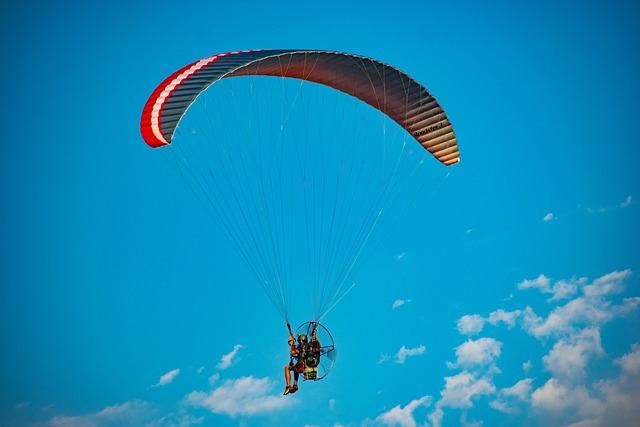Paramotoring is a thrilling sport that combines the freedom of flying with the excitement of motorized equipment. It involves flying a paraglider with a small motor strapped to the pilot’s back, allowing for vertical take-off and landing. While paramotoring can be a great way to explore the world from a unique perspective, finding the perfect spot where to take off with a paramotor can be challenging.
In this article, I will explore the legalities and regulations around paramotoring, as well as the ideal locations for take-off. I will also discuss the challenges of finding suitable take-off locations and provide tips for finding safe sites, ensuring that you can enjoy this exciting sport with peace of mind.
Understanding the Legalities of Paramotoring
Before embarking on any paramotoring activity, it is essential to understand the legalities and regulations surrounding the sport. In the United States, paramotoring is considered a type of ultralight aviation, which means it falls under the jurisdiction of the Federal Aviation Administration (FAA). Here are some important things to keep in mind:
- A valid pilot’s license is not required for paramotoring, but the FAA recommends that pilots undergo proper training and certification before taking to the skies.
- The maximum weight of the aircraft, including the pilot and fuel, should not exceed 254 pounds for a single-seat vehicle or 436 pounds for a two-seater vehicle.
- It is essential to follow all airspace regulations and restrictions, including those surrounding airports and military bases.
- It is illegal to operate a paramotor for commercial purposes without obtaining the necessary permits and licenses.
- It is crucial to understand and adhere to any state or local laws regarding paramotoring, including restrictions on where you can take off and land.
Ideal Locations for Paramotor Take-Off
Finding a suitable location for paramotor take-off can make or break a successful flight. Here are 5 of the ideal locations for paramotor take-off:
- Public Parks and Open Spaces: Public parks and open spaces, such as large fields, are ideal for paramotor take-off as they offer plenty of space and little to no obstacles to navigate.
- Airfields and Aerodromes: Airfields and aerodromes are excellent for paramotor take-off as they have been designed for aviation activities and often have the necessary facilities, including hangars, runways, and fuel.
- Mountains and Hills: Mountains and hills provide a scenic backdrop and are suitable for paramotoring, as the altitude provides an excellent opportunity for soaring flights.
- Beaches: Beaches offer vast stretches of flat land that are perfect for paramotor take-off. However, it is essential to check for any local regulations or restrictions before taking off from a beach.
- Deserts and Open Fields: Deserts and open fields offer vast expanses of flat, open space with little to no obstacles, making them perfect for paramotoring.
Factors to consider while choosing a take-off location include wind direction and speed, visibility and terrain conditions, obstacles and hazards, noise and disturbance to the local population, and accessibility and proximity to emergency services. It is important to choose a location that is suitable for your level of experience and ability.
Challenges of Finding Paramotor Take-Off Locations
While there are many ideal locations for paramotor take-off, there are also several challenges to consider when trying to find suitable locations:
- Crowded public spaces: Public parks and open spaces can be crowded, making it challenging to find a suitable area for take-off without interfering with other park visitors.
- Private land and permission issues: Many ideal locations for paramotor take-off are on private land, which requires obtaining permission from the landowner before taking off.
- Airspace restrictions: Airspace restrictions can make it difficult to find suitable locations for paramotor take-off, particularly near airports or military bases.
- Adverse weather conditions: Adverse weather conditions, such as high winds or heavy rain, can make it difficult to find a suitable location for take-off.
It is important to plan ahead and research potential take-off locations thoroughly before heading out to ensure that you can find a suitable location that meets your needs and adheres to local regulations. Additionally, it is crucial to obtain permission from landowners and follow all rules and regulations surrounding paramotoring to ensure the safety of yourself and others.
Tips for Finding Safe Paramotor Take-Off Sites
Here are some tips for finding safe paramotor take-off sites:
- Research online and connect with local paramotor clubs: Online resources and local paramotor clubs can provide valuable information on ideal take-off locations, regulations, and local weather conditions.
- Get permission from landowners: When considering take-off locations on private land, it is essential to obtain permission from the landowner before taking off.
- Respect the rules and regulations: Always adhere to local regulations, including airspace restrictions and any laws governing paramotoring.
- Follow weather forecasts and avoid adverse weather conditions: Check weather forecasts before heading out to ensure that conditions are suitable for flying. Avoid adverse weather conditions, including high winds, heavy rain, or lightning.
- Carry safety equipment and tools: Always carry appropriate safety equipment, including a helmet, radio, and GPS, and be sure to have tools on hand for any necessary repairs.
Conclusion
In conclusion, finding a suitable location for paramotor take-off is essential for a successful and safe flight. It is important to understand the legalities and regulations surrounding paramotoring, including obtaining proper training and certification and following all rules and regulations set forth by the FAA and local authorities.
Ideal locations for paramotor take-off include public parks and open spaces, airfields and aerodromes, mountains and hills, beaches, deserts, and open fields. However, there are several challenges to finding suitable take-off locations, including crowded public spaces, private land and permission issues, airspace restrictions, and adverse weather conditions.
By following tips such as researching online, obtaining permission from landowners, respecting regulations, following weather forecasts, and carrying safety equipment and tools, you can help ensure a safe and enjoyable paramotoring experience. Remember to always prioritize safety and respect the rules and regulations surrounding the sport.




